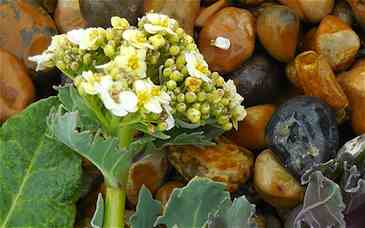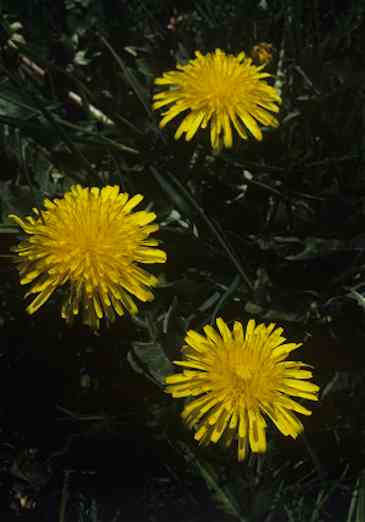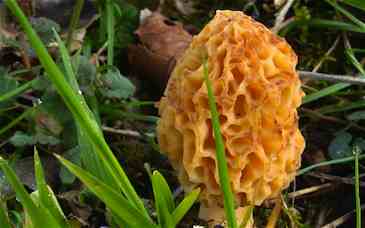
Roger Phillips, author of a new book on foraging, shares his top 10 springtime finds and throws in four recipes that combine them to best effect for your springtime dinner parties.
1. Sea beet (Beta vulgaris)
The parent of Swiss chard and beetroot, this is common on pebbly beaches just above the tide line. Perfect in soups or as a vegetable in place of spinach.
2. Dandelion (Taraxacum officinale)
Sprinkle on salads and eat raw

3. Stinging nettle (Urtica dioica)
Picked when young, nettles can be used as a green vegetable, but they work best of all as a soup with a unique flavor. If the plant gets too tall to pick, just cut the nettles to ground level and crop it again after about three weeks.
4. Sea kale (Crambe maritime)
Another common plant of pebbly beaches, Dungeness has loads of it. The flower buds make a terrific vegetable.
5. Elder Flowers (Sambucus nigra)
Elderflower drinks can now be bought commercially but nothing beats making the sparkling stuff yourself.
6. Morel (Morchella esculenta)
This tasty mushroom used to be commonly found with elm trees but is now hard to find. You’ll usually spot it on chalky soil with ash, apple or pines.
Common in grassland, sorrel makes a perfect piquant sauce for fish, or use it to make a special pesto for pasta.
8. Claytonia (Montia perfoliata)
Found on waste ground or as a garden weed. A great salad leaf
9. Watercress (Rorippa aquaticum)
A common plant of streams and waterways. Although sold commercially, collecting it yourself is always more fun. Watercress soup is my favourite.
10. Lime flowers (Tilia europaea)
Linden or lime tea is one of the greatest of the so-called herb teas or tisanes, wonderfully scented from the flowers.
SPRING RECIPES WITH FORAGED INGREDIENTS
Sorrel pesto
\Serves five to six
1 lb (400g) sorrel
8oz (200g) spinach, preferably baby leaf annual variety,
2oz (50g) pine nuts
Garlic (to taste)
Sea salt (to taste)
Olive oil added to achieve the correct thickness.
Wash and dry the sorrel and spinach leaves. Aim for around a 2-1 ratio for a sauce that has a zesty punch but also allows that iron-y flavour of the spinach to come across too.
Place the leaves, pine nuts, garlic, sea salt and olive oil in the blender bowl. Gradually add olive oil to achieve a desirable thickness. If you plan on storing the sauce it will keep much better with a good layer of oil above it.
This recipe was given to me by Phil Stanley, the great pesto maker.
Watercress soup
Serves four
2 bunches watercress
2 large potatoes
Generous knob of butter
Dash of vegetable oil (to stop butter burning)
1 chicken stock cube
Salt and freshly ground black pepper
Single cream
Put the butter in a large saucepan with dash of oil and melt over a low flame. Place a mandolin over the saucepan and slice the potatoes (or cube them). Cook very gently until the potatoes are soft. Dissolve the stock cube in the boiling water and add to the saucepan, simmering for 15 minutes. Then add the watercress (coarsely chopped) and simmer for a further 7 minutes (retain some watercress leaves for garnish). Liquidize, stir in some single cream and chill in the fridge. Decorated with fresh watercress leaves, it makes a delightful summer soup.
This recipe, which comes from Pammy Williams, is equally delicious served either cold in the summer or hot in the winter.
Lime or linden tea
Infuse one teaspoon of dried lime flowers in one cup of water for 5-10 minutes.
Strain and drink as it comes, or with a little sugar. Lime tea has a lovely, honey-like scent and is said to be soothing to the digestion and nerves, so it is often taken last thing at night to help induce sleep.
Mousse chaude aux morelles
Serves four
4 large morels, washed thoroughly
100g (4 oz) white mushrooms
2 large chicken breasts, boned
1 ½ dl (½ pint) double cream
3 dl (½ pint) velouté sauce
1 tablespoon Madeira
35g (1 ½ oz) butter
Salt and pepper
Liberally butter the inside of four teacups. Cut one morel into quarters lengthways and each quarter into five pieces. Cook very lightly in 12g (½ oz) of the butter.
Place the pieces inside the teacups equi-distant from each other. If you have no morel large enough, cut up a smaller one similarly and simply place it, star-fashion, in the bottom of the teacup.
Filling: Chop the remaining morels (with their stalks) and the other mushrooms very finely and cook gently in the rest of the butter until the moisture has evaporated. Season and mix half with the velouté sauce and half the Madeira. Cool.
Mousse: Finely chop the chicken breasts, trimmed of all sinew, or put in food processor for twenty seconds. Pass this, with the other half of the mushroom mixture, through a sieve into a small bowl. Place over some ice cubes and water in a large bowl and refrigerate for half an hour. Then, salt the mixture lightly and little by little beat in the chilled cream. Check for the right degree of saltiness. Divide the mousse into four and line each teacup with it to a thickness of 1.2cm (½ in), making sure the morel pieces remain in place, leaving enough mousse to cover the top.
Fill the cavities with the chopped mushroom mixture and spread the remaining mousse over the top. Bake in a bain-marie in a medium oven 180˚C (350˚F, Mark 4) for half an hour, turn out and serve with the rest of the Madeira-flavoured sauce poured around.
This recipe came to me from Chef Stephen Bull.
*Wild Food: A Complete Guide for Foragers by Roger Phillips, Macmillan, £15.50
Elderflowers in a bowl
Spring-time snack: foraged elderflower makes a delicious spring drink
